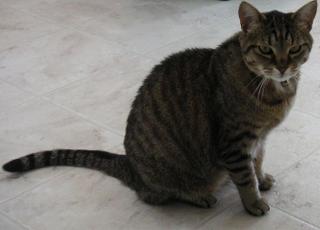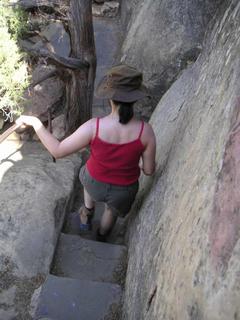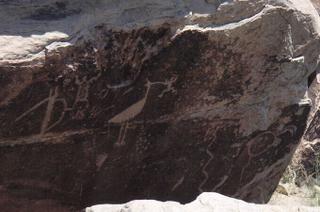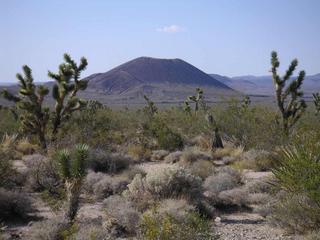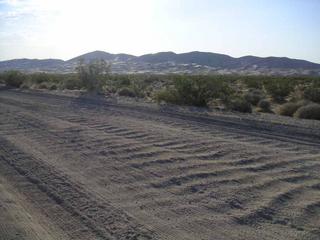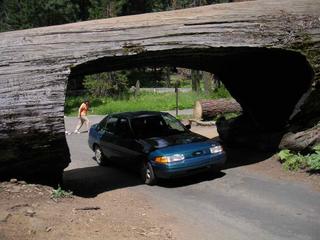After a large buffet breakfast at our hotel, we left Bakersfield, CA in the already-too-hot morning and drove eastward. Made stops in Barstow (for gas and drinks) and Baker, where the Visitor Center for the Mojave National Preserve is located. The center was blissfully cool, and had a large selection of field guides, photos and displays available in its fairly small space. The photo from space of the region was really neat: we could see Las Vegas, the Colorado River, and the large expanse of desert where we were. We discovered that the spring had been unusually wet, which caused the desert to bloom spectacularly and affect the wildlife as well. Unfortunately we missed the height of these displays.
The visitor center also informed us that the air outside was 113F (it was noon) and would be rising for a few hours yet. But being intrepid adventurers, we soldiered on in spite of the heat. (Keep in mind we had been using the car’s air conditioning for only about 10min a day and only for a few days so far, since the A/C causes the car to perform rather poorly.)
Tucked in between Interstates 15 and 40 is the Mojave National Preserve, where 3 of North America’s 4 desert systems collide. It’s a beautiful place with many different landscapes to explore. Only in the 1990’s did it get set aside as a natural area to preserve, so it’s rather unvisited and there are very few services within the park.
We took the Cima Road exit and headed south through the center of the Preserve. This gave us spectacular views of a set of mountains all around us, and our first close-up view of Joshua trees. These plants are actually one of three types of yuccas we saw in the park. Nevertheless they were beautiful in their odd, branched shapes and poofs of spiky leaves. We decided that, in spite of the heat, we had to explore outside of the car at least once, so we opted to take one of the few short trails – Teutonia Peak. This led us around a variety of yucca plants, many cacti and large rocks jutting out at odd angles. (Maybe these rocks were thrown here from volcanic activity in the region.) Even though it was 120F (that’s 50C!!), we managed to spot some wildlife too! There was an American kestral, scrub jays, and a lot of small birds we couldn’t identify. We also spotted a number of cute desert cottontails (which really looked like cartoon-cute bunnies) and several white-tailed antelope squirrels. These ground squirrels run with their tails flipped up along their back, exposing the brilliant white underside of the tails. Having to adapt to desert life, the antelope squirrel eats just about anything, and the ranger in Baker had informed us of seeing them with lizards in their mouths! And we did see ground squirrels eating the remnants of jackrabbits left by car collisions. Yuck!
Because of the intense heat, we had to turn back before reaching the end of the trail. The feel of the air blowing past was sometimes verging on painful, and anything that was exposed to the sun instantly heated up to an uncomfortable temperature. Up to this point of the trip I have had to carry the digital camera in my pocket to keep it warm enough to function well – today I had to keep it in my pocket so that it didn’t get much hotter than the ambient air temperature! Every time the strap on my shoulder bag shifted it would push another section of my shirt against my skin and feel like I was being scalded. After a couple hours exploring under these conditions we were both overheated, sluggish, and had completely lost our appetites. Thankfully we had wide brimmed hats, lots of sunscreen and two bottles of water or we may have regretted our walk. The car, upon our return, was too hot to touch despite the shade of a nearby mesquite bush but it was a welcome sight none the less.
After a cooling off period (with ice water in our cooler – that saved us today!), we drove further south, finally reaching the Kelso Depot. This elaborate building had once served as the train station for the Union Pacific Railway, but had been abandoned for years. The Preserve has been renovating it to use as its headquarters and visitors center, and should open soon.
Here, we turned north along Kelbaker Road, on which we drove about 15 miles to the lava beds. These rocks and large cinder cones were the shiny black we had expected to see at the Crater Lake Pumice Desert.
We turned around and headed south again, and had a wonderful view of the Kelso Dunes. These sandy-looking dunes certainly looked like the desert of Hollywood movies! They apparently made cool noises, from low rumblings to higher-pitched sounds. We tried to take the washboard road out to the dunes trailhead, but after about 1 mile, the car was not in good shape and we were overheating. So we had to turn around.
The other-worldly landscape did not end there, however. Near the south end of that road, we went through Granite Pass and Quail Flats, where we saw and heard quail. (It was late afternoon by that point, so more wildlife was starting to emerge.) The granite peaks were jagged and unlike mountains elsewhere!
Once we left the park, it was interstate driving through more desert. Sunset saw pastel pinks and purples and the desert peaks silhouetted. We drove into darkness and stopped for the night in Needles, CA, along the Colorado River and at the Arizona border. We’ll have to return to the Mojave some day, preferably in spring during a wet year to see the desert in bloom and to spend more time (when we won’t be in danger of heat stroke).

